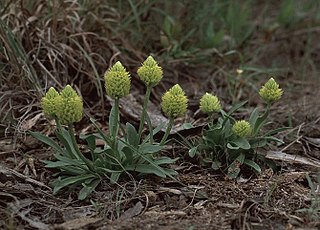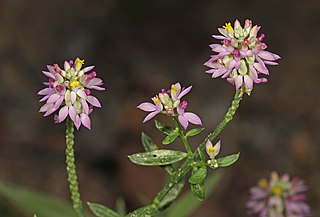
Polygala is a large genus of flowering plants belonging to the family Polygalaceae. They are commonly known as milkworts or snakeroots. The genus is distributed widely throughout much of the world in temperate zones and the tropics. The genus name Polygala comes from the ancient Greek "much milk", as the plant was thought to increase milk yields in cattle.

Polygala vulgaris, known as the common milkwort, is a herbaceous perennial plant of the genus Polygala in the family Polygalaceae.

Polygaloides paucifolia, synonym Polygala paucifolia, known as gaywings or fringed polygala, is a perennial plant of the family Polygalaceae.

Rhinotropis acanthoclada, synonym Polygala acanthoclada, is a species of flowering plant in the milkwort family known by the common names desert polygala and thorn milkwort. It is native to the desert woodlands of the southwestern United States from Utah to the Mojave Desert. It is a small, bushy shrub spreading or growing erect and approaching one meter in maximum height. It is hairy in texture, the youngest twigs hairiest with a feltlike coat of short, whitish fibers. The lance-shaped or oval leaves are up to 2.5 centimeters long. Some of the twigs narrow to spines at the tips, especially in the inflorescences. The flowers are solitary or in clusters of up to 15. Each flower has five sepals, the lateral two white in color and spreading out like wings. The middle petal is keeled, with a flat tip protruding. The fruit is a capsule about half a centimeter long.

Polygala lewtonii is a rare species of flowering plant in the milkwort family known by the common name Lewton's polygala, or Lewton's milkwort. It is endemic to Florida in the United States, where it is limited to the central ridge of the peninsula. There are about 49 occurrences of the plant remaining. Most occurrences contain very few plants. The species is threatened by the loss and degradation of its habitat. This is a federally listed endangered species of the United States.

Polygala calcarea, the chalk milkwort, is a species of flowering plant in the family Polygalaceae, native to western Europe. It is a delicate mat-forming evergreen perennial growing to 5 cm (2 in) tall by 20 cm (8 in) broad, with spikes of small, vivid deep blue flowers in spring, and leathery, oval leaves. The white anthers of the flowers may possibly be the source of the name milkwort.

Polygala senega is a species of flowering plant in the milkwort family, Polygalaceae. It is native to North America, where it is distributed in southern Canada and the central and eastern United States. Its common names include Seneca snakeroot, senega snakeroot, senegaroot, rattlesnake root, and mountain flax. Its species name honors the Seneca people, a Native American group who used the plant to treat snakebite.

Polygala sanguinea, known as purple milkwort or field milkwort, is an annual plant in the family Polygalaceae.

Polygala myrtifolia, the myrtle-leaf milkwort, is an evergreen 2-4m tall South African shrub or small tree found along the southern and south-eastern coasts, from near Clanwilliam in the Western Cape to KwaZulu-Natal. It is a fast-growing pioneer plant, a typical fynbos component, and may be found on dunes, rocky places, along forest margins, beside streams, and in open grassland. It belongs to the milkwort family of Polygalaceae.
Hebecarpa rectipilis, synonym Polygala rectipilis, common name New Mexico milkwort, is a plant native to one county in New Mexico and to northeast Mexico. The type specimen was collected near the Town of Hillsboro in Sierra County, at an elevation of 1065 m.

Polygala curtissii, the Curtiss' milkwort or Appalachian milkwort, is a species of flowering plant in the milkwort family. It is native to the Southeastern United States, where it is found primarily in the southern Appalachian Mountains and the Piedmont. Its natural habitat is open, sandy meadows, and woodlands.

Polygala nana, commonly known as candyroot or low bachelors' buttons, is a small herbaceous plant native to the southeastern United States. The root has a sweet liquorice flavor when it is chewed, but it is usually hidden underground until the plant flowers. The seeds of candyroot are dispersed by ants.

Polygala cruciata, commonly called drumheads milkwort, is a species of flowering plant in the milkwort family. It is native to eastern North America, where it is found in scattered localities, particularly around the Coastal Plain, the Great Lakes, and the southern Appalachian Mountains. It is found most often in wet, sandy prairies and marshes.

Hebecarpa macradenia, synonym Polygala macradenia, the glandleaf milkwort, is a subshrub in the milkwort family (Polygalaceae) found in the Arizona Uplands of the Sonoran Desert. Its "odd" flowers are said to be "spectacularly beautiful" when viewed with a hand lens.

Polygala lutea, commonly known as orange- or yellow milkwort, is a plant in the milkwort family (Polygalaceae) native to pine-barren depressions and swamps in costal areas of the southern and eastern the United States. It was first described in 1753 by Carl Linnaeus.
Polygala chapmanii is a flowering plant species in the milkwort family (Polygalaceae). It is endemic to states in the southeastern United States bordering the Gulf of Mexico including Alabama and parts of the Florida panhandle but is not reported from Texas. It is an annual and grows to about two feet tall. It is a dicot.

Polygala mariana, the Maryland milkwort, is a species of flowering plant in the milkwort family (Polygalaceae). It is endemic to the southern and eastern United States. It is an annual with a height between 4 and 16 inches and it flowers between June and October.
Polygala ramosa is a species of flowering plant in the milkwort family (Polygalaceae). It is endemic to the coastal areas of the Southern and Eastern United States. It is an annual herb with a height of 10 to 40 centimetres that produces yellow flowers between the months of May and September.
Polygala boykinii, known by the common name Boykin's milkwort, is a species of flowering plant. It grows to about 2 feet high and produces a spear of white flowers. It is a dicot in the Polygalaceae family. It has been collected in Florida and Alabama.














